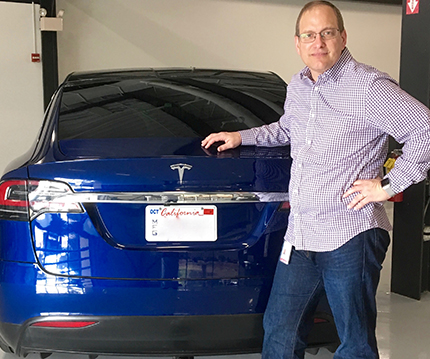Alumnus Starts New Adventure
Charlie Kuehmann ('94) becomes vice president of materials engineering for SpaceX and Tesla
Charles Kuehmann was born into a family of entrepreneurs. His great grandfather owned Kuehmann Potato Chips, a late 1800s snack operation, and his father operated a marina along the Colorado River. To date, Kuehmann himself has founded three businesses, including QuesTek, a new-materials design firm.
 In December, Kuehmann (McCormick ’94) became the vice president of materials engineering at both Tesla Motors and SpaceX, working on the future of electric cars and interplanetary travel, respectively. He is the only employee — besides CEO and South African entrepreneur Elon Musk — who splits his time between the two companies, a role he described as “crazy.” Before joining the moonshot operation, Kuehmann led a product design team at Apple.
In December, Kuehmann (McCormick ’94) became the vice president of materials engineering at both Tesla Motors and SpaceX, working on the future of electric cars and interplanetary travel, respectively. He is the only employee — besides CEO and South African entrepreneur Elon Musk — who splits his time between the two companies, a role he described as “crazy.” Before joining the moonshot operation, Kuehmann led a product design team at Apple.
“Charlie has a vision,” said Christopher Schuh, head of the Department of Materials Science and Engineering at the Massachusetts Institute of Technology and Kuehmann’s colleague. “He has an entrepreneurial spirit and happens to be very technically deep on the thermodynamics and physics of metals. Those properties together have put him in a very unique position to help show the world where it’s going in terms of the design of new materials.”
Kuehmann grew up in Bullhead City, Arizona, a small town located about 100 miles south of Las Vegas. A product of the Apollo era, when U.S. astronauts landed on the moon, the budding engineer divided his time between imagining life in space and running an athletic medicine office at his local high school.
“I played around a lot with things, taking them apart, putting them back together,” he said. “I was pretty mechanically inclined.”
After high school, the young entrepreneur received a scholarship to attend Arizona State University, where he graduated summa cum laude with a degree in aerospace engineering. While at school, Kuehmann recalled building an advanced engine for American aerospace company AlliedSignal that exploded after only 20 hours. His team had made a miscalculation of the turbine temperature, which reduced the engine’s life dramatically. The experience taught Kuehmann that in order to improve design, he had to first improve materials.
Gradually, Kuehmann’s focus began to shift away from design and toward materials. After college, he received a prestigious National Science Foundation grant, and in 1988 he began to pursue his Ph.D in NU’s department of Materials Science and Engineering.
At the same time, McCormick Prof. Gregory Olson, who also had an interest in materials and design, was transitioning from MIT to NU. Olson, named the “father of materials design” by the American Academy of Arts and Sciences, had an idea to utilize computing software to lower the cost of materials creation.
Kuehmann became one of Olson’s first graduate students at NU, where the two worked together to hone computer models they hoped would reduce the cost of developing new metals. In 1996, unable to elicit interest from any other engineering companies in the industry, the two co-founded their own company, QuesTek. Straightaway, they received contracts from major clients, such as Newman/Haas Racing and the U.S. Navy, and later worked with SpaceX.
Friends and former colleagues, including Olson, described Kuehmann as a “jack of all trades,” capable of handling both the business and technical sides behind QuesTek. This, Olson added, made him the ideal CEO. McCormick Prof. David Seidman, who taught Kuehmann in graduate school, said he was the type of guy with whom “you wouldn’t mind sharing a beer.”
After a three-year stint at Apple, Kuehmann reignited his childhood passion for space travel last December when he took the job at Tesla and SpaceX. A far cry from grade school daydreams, today Kuehmann splits his time between combating the risk of human extinction and curbing fossil fuel emissions.
“If we can’t move away from fossil fuels, we’re going to destroy our environment,” he said. “Long term, the risks are very high that either something natural or man-made is going to have a significant aversive effect on our planet. The capability to colonize and exist outside of (Earth) is probably the only weapon in the toolbox to address that risk.”
Kuehmann said he would like to explore space, too, if ever given the chance. But for now, safely grounded on Earth, Kuehmann spends a lot of time with his family and rides bikes to stay in shape.
“I’m bringing materials design and engineering into commercial spaces and starting to plant a seed,” he said. “When I got out of graduate school, materials design was a stage zero company. Now we’re at the point where I’ve been at three different commercial companies establishing materials design teams. That’s probably the biggest part of my legacy.”
